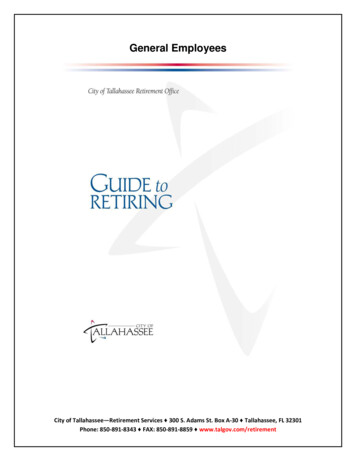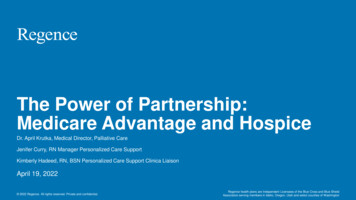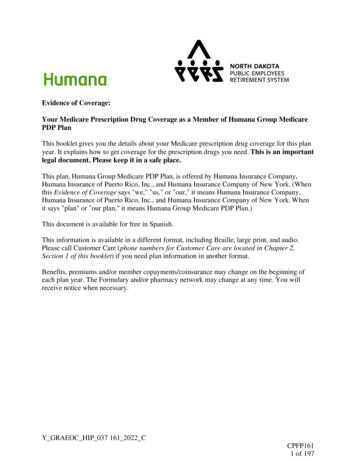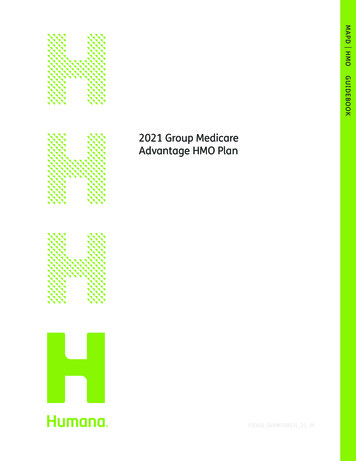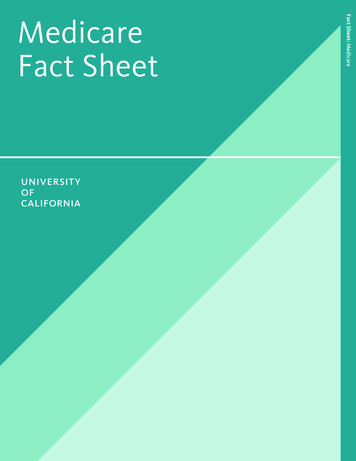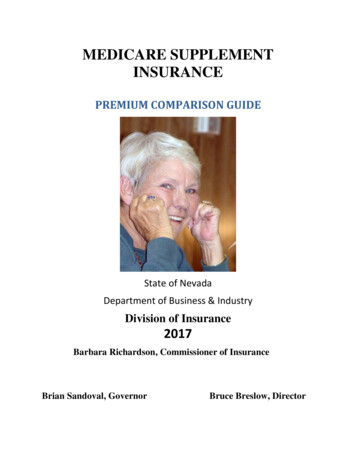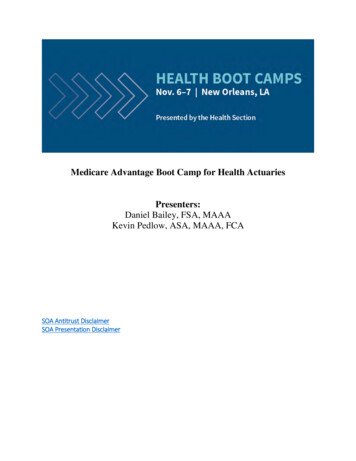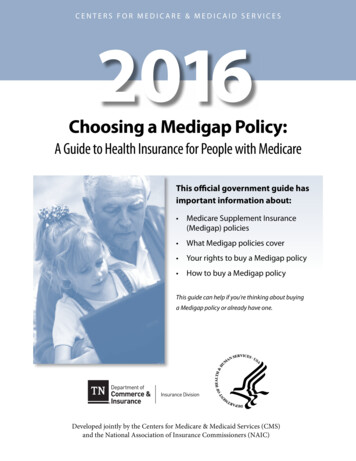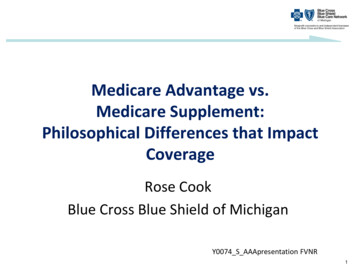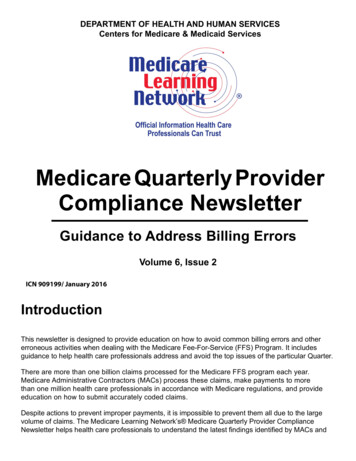
Transcription
DEPARTMENT OF HEALTH AND HUMAN SERVICESCenters for Medicare & Medicaid ServicesMedicare Quarterly ProviderCompliance NewsletterGuidance to Address Billing ErrorsVolume 6, Issue 2ICN 909199/ January 2016IntroductionThis newsletter is designed to provide education on how to avoid common billing errors and othererroneous activities when dealing with the Medicare Fee-For-Service (FFS) Program. It includesguidance to help health care professionals address and avoid the top issues of the particular Quarter.There are more than one billion claims processed for the Medicare FFS program each year.Medicare Administrative Contractors (MACs) process these claims, make payments to morethan one million health care professionals in accordance with Medicare regulations, and provideeducation on how to submit accurately coded claims.Despite actions to prevent improper payments, it is impossible to prevent them all due to the largevolume of claims. The Medicare Learning Network’s Medicare Quarterly Provider ComplianceNewsletter helps health care professionals to understand the latest findings identified by MACs and
other contractors such as Recovery Auditors and the Comprehensive Error Rate Testing (CERT)review contractor, in addition to other governmental organizations such as the Office of the InspectorGeneral (OIG).The newsletter is released on a quarterly basis. An archive of previously-issued newsletters, whichincludes keyword and provider-specific indices, is available on the Centers for Medicare & MedicaidServices’ (CMS) website.Comprehensive Error Rate Testing (CERT): CommodesProvider Types Affected: Physicians, Non-physician Practitioners (NPPs) and Equipment (DME)SuppliersProblem DescriptionMedicare covers Durable Medical Equipment (DME) as long as the equipment is medically necessary and aphysician or Non-physician Practitioner (NPP) prescribes it for use in the beneficiary’s home. The NationalCoverage Determination (NCD) for DME Reference List (NCD 280.1), although not an exhaustive list, providescategories of DME and coverage status.The term DME is defined as equipment which: Can withstand repeated use; that is, could normally be rented and used by successive patients; Is primarily and customarily used to serve a medical purpose; Generally is not useful to a person in the absence of illness or injury; and Is appropriate for use in a patient’s home.Commodes are covered by Medicare if the beneficiary is confined to bed or is “room confined.” The term “roomconfined” means that the patient’s condition is such that leaving the room is medically contraindicated. Theaccessibility of bathroom facilities generally would not be a factor in this determination. However, confinement of apatient to a home in a case where there are no toilet facilities in the home may be equated to room confinement.Moreover, payment may also be made if a patient’s medical condition confines him to a floor of the home andthere is no bathroom located on that floor.Problem DescriptionThe CERT program reports detailed results annually in the supplementary appendices. During the 2014report period,the improper payment rate for Commodes/Bed Pans/Urinals was 94.7% with projected improper payments ofapproximately 30 million.Commodes: Frequently used Healthcare Common Procedure Coding System (HCPCS) codes forcommodes are: E0163 - Commode chair, mobile or stationary, with fixed arms E0165 - Commode chair, mobile or stationary, with detachable armsMedicare does not automatically assume payment for a Durable Medical Equipment, Prosthetics,Orthotics and Supplies (DMEPOS) item that was covered prior to a beneficiary becoming eligible for theMedicare Fee-for-Service (FFS) program. When a beneficiary receiving a DMEPOS item from anotherpayer (including Medicare Advantage plans) becomes eligible for the Medicare FFS program, Medicarewill pay for continued use of the DMEPOS item only if all Medicare coverage, coding and documentationrequirements are met. Additional documentation to support that the item is reasonable and necessary maybe required upon request of the DME Medicare Administrative Contractor (MAC).
Finding: Insufficient Documentation Causes Most Improper PaymentsMost improper payments were due to insufficient documentation. Insufficient documentation means that something was missing from the medical records. Some examples are: All items billed to Medicare require a prescription. An order for each item billed must be signed and dated. For a commode to be covered by Medicare, a Detailed Written Order (DWO) must be received by thesupplier before a claim is submitted. If the supplier bills for a commode without first receiving the completedDWO, it will be denied as not reasonable and necessary. The equipment must be provided by a supplier that is enrolled in Medicare.Although someone other than the ordering physician may produce the DWO, the ordering physician or NPPmust review the content and sign and date the document. The DWO must contain: The beneficiary's name; The physician's/NPP's name; Date of the order and the start date, if start date is different from the date of the order; Detailed description of the item(s): the detailed description in the written order may be either a narrativedescription or a brand name/model number; Physician/NPP signature and signature dated by the treating physician/practitioner, kept on file by thesupplier, and made available upon request; signature and date stamps are not allowed; and The prescribing physician's/NPP's National Provider Identification (NPI).For commode claims, documentation in the beneficiary's medical record must justify the medical need for acommode.Examples of Improper PaymentsInsufficient Documentation – No clinical recordsA medical supply company billed for a commode (HCPCS E0163) for a date of service in November 2014. Thedocumentation submitted, in response to an initial request for medical records, included a signed and datedorder for a commode and proof of delivery.The submitted documentation was missing medical records to support that the beneficiary is confined to bedor is “room confined.” There was no response to a request for additional documentation. As a result, the claimwas scored as an insufficient documentation error and the MAC recouped payment for HCPCS E0163 from themedical supply company.Insufficient Documentation – Missing documentation that the beneficiary is confined to bed or is “roomconfined.”A medical supply company billed for a commode (HCPCS E0163) for a date of service in July 2014. The documentation submitted, in response to an initial request for medical records, included a signed and dated orderfor a commode, proof of delivery and clinical records.The supplier submitted hospital records dated one week prior to the date of service documenting that the beneficiary had fallen and suffered rib fractures. The documentation did not indicate that the beneficiary is confinedto bed or is “room confined.” The supplier also submitted a physician’s visit note dated one year after the dateof service. Medical reviewers will generally consider medical records dated from 12 months prior to the date ofservice through 6 months after the date of service to support that the beneficiary is confined to bed or is “roomconfined.”This claim was scored as an insufficient documentation error and the MAC recouped payment for HCPCSE0163 from the medical supply company.Insufficient Documentation – Missing documentation that the beneficiary is confined to bed or is “roomconfined.”A medical supply company billed for a commode (HCPCS E0163) for a date of service in February 2015. Thedocumentation submitted, in response to an initial request for medical records, included a signed and dated
order for a commode and proof of delivery. The supplier also submitted a home safety checklist and progressnotes that did not support that the beneficiary is confined to bed or is “room confined.”In response to a request for additional documentation, the supplier submitted a progress note dated fivemonths after the date of service which did not show necessity for the commode. Medical reviewers will generally consider medical records dated from 12 months prior the date of service through 6 months after the date ofservice to support that the beneficiary is confined to bed or is “room confined.”This claim was scored as an insufficient documentation error and the MAC recouped payment for the E0163from the medical supply company.ResourcesYou can find more information on how to avoid errors on claims for Commodes in these resources: The National Coverage Determination for DME Reference List (NCD 280.1); Local Coverage Determinations, for example, L33736, and Articles, such as A52461; “Medicare Claims Processing Manual,” Chapter 20, “Medical Equipment, Prosthetics and Orthotics, andSupplies (DMEPOS);” MLN Matters Article MM8304 on Detailed Written Orders and Face-to-Face Encounters; Medicare Coverage of Durable Medical Equipment and Other Devices, CMS Pub. 11045, September 2015;and The Supplementary Appendices for the Medicare Fee-for-Service 2014 Improper Payments Report.Comprehensive Error Rate Testing (CERT): How to Avoid Errors on Claims forManual WheelchairsProvider Types Affected: Physicians, Non-physician Practitioners (NPPs) and Durable MedicalEquipment SuppliersBackgroundAs a condition for payment, Section 6407 of the Affordable Care Act requires a physician to document thatthe Physician, Physician Assistant (PA), Nurse Practitioner (NP), or Clinical Nurse Specialist (CNS) has hada face-to-face encounter examination with a beneficiary in the six (6) months prior to the written order forcertain items of Durable Medical Equipment (DME), including manual wheelchairs.Mobility Assistive Equipment (MAE) is reasonable and necessary for beneficiaries who have a personalmobility deficit sufficient to impair their participation in Mobility-Related Activities of Daily Living (MRADLs),such as toileting, feeding, dressing, grooming, and bathing in customary locations within the home.Determination of the presence of a mobility deficit will be made by an algorithmic process, Clinical Criteriafor MAE Coverage, to provide the appropriate MAE to correct the mobility deficit. Manual wheelchairs arecovered if a physician or Non-Physician Practitioner (NPP) determines that the beneficiary has a mobilitydeficit and that the manual wheelchair is reasonable and necessary using the clinical criteria algorithm (SeeNational Coverage Determination 280.3 B in the resources section below).Problem DescriptionThe CERT program reports detailed results annually in the supplementary appendices. During the 2014report period, the improper payment rate for standard manual wheelchairs was 84.6% with projected improperpayments of approximately 170 million.
Wheelchairs:Medicare covers several variations of manual wheelchairs. The Healthcare Common Procedure CodingSystem (HCPCS) codes for manual wheelchairs are as follows: K0001 Standard K0002 Standard hemi (low seat) wheelchair K0003 Lightweight wheelchair K0004 High strength, lightweight wheelchair K0005 Ultra lightweight wheelchair K0006 Heavy duty wheelchair K0007 Extra heavy duty wheelchair K0008 Custom manual wheelchair/base K0009 Other manual wheelchair/baseFinding: Insufficient Documentation Causes Most Improper PaymentsMost improper payments for wheelchairs were due to insufficient documentation. Insufficient documentationmeans that something was missing from the medical records. Some examples are: All items billed to Medicare require a prescription. An order for each item billed must be signed and dated. For a manual wheelchair to be covered by Medicare, a detailed written order (DWO) must be receivedby the supplier before a claim is submitted. If the supplier bills for a wheelchair without first receiving thecompleted DWO, it will be denied as not reasonable and necessary. The equipment must be provided by a supplier that is enrolled in Medicare.Although someone other than the ordering physician may produce the DWO, the ordering physician or NPPmust review the content and sign and date the document. It must contain: The beneficiary's name; The physician's/NPP's name; Date of the order and the start date, if start date is different from the date of the order; Detailed description of the item(s): the detailed description in the written order may be either a narrativedescription or a brand name/model number; Physician/NPP signature and signature dated by the treating physician/practitioner, kept on file by thesupplier, and made available upon request; signature and date stamps are not allowed, and The prescribing practitioner’s National Provider Identification (NPI).For wheelchair claims, documentation in the beneficiary's medical record must justify the medical need for awheelchair.General Coverage Criteria for Manual WheelchairsCoverage requirements for manual wheelchairs are described below in criteria A through G. A manualwheelchair and accessories for use inside the home (E1037 - E1039, E1161, K0001 - K0009) are covered if: Criteria A, B, C, D, and E are met; and Criterion F or G is met.
Criteria:A. The beneficiary has a mobility limitation that significantly impairs his/her ability to participate in one or moreMRADLs such as toileting, feeding, dressing, grooming, and bathing in customary locations in the home. Amobility limitation is one that:1. Prevents the beneficiary from accomplishing an MRADL entirely; or2. Places the beneficiary at reasonably determined heightened risk of morbidity or mortality secondary to theattempts to perform an MRADL; or3. Prevents the beneficiary from completing an MRADL within a reasonable time frame.B. The beneficiary’s mobility limitation cannot be sufficiently resolved by the use of an appropriately fitted caneor walker.C. The beneficiary’s home provides adequate access between rooms, maneuvering space, and surfaces foruse of the manual wheelchair that is provided.D. Use of a manual wheelchair will significantly improve the beneficiary’s ability to participate in MRADLs andthe beneficiary will use it on a regular basis in the home.E. The beneficiary has not expressed an unwillingness to use the manual wheelchair that is provided inthe home.F. The beneficiary has sufficient upper extremity function and other physical and mental capabilities neededto safely self-propel the manual wheelchair that is provided in the home during a typical day. Limitations ofstrength, endurance, range of motion, or coordination, presence of pain, or deformity or absence of one orboth upper extremities are relevant to the assessment of upper extremity function.G. The beneficiary has a caregiver who is available, willing, and able to provide assistance with the wheelchair.Note: Physicians may use code G0454 (Physician documentation of face-to-face visit for Durable MedicalEquipment determination performed by Nurse Practitioner, Physician Assistant or Clinical Nurse Specialist)for signing or co-signing the face-to-face encounter of the NP/PA/CNS. The physician should not bill theG code when he/she conducts the face-to-face encounter. Note that the G code may only be paid to thephysician one time per beneficiary per encounter (paid based on Medicare Administrative Contractor (MAC)judgment), regardless of the number of covered items documented in the face-to-face encounter.Examples of Improper PaymentsInsufficient Documentation – No documentation of mobility limitationA medical supply company billed for a manual wheelchair (HCPCS K0001) for a date of service in January 2015.The documentation submitted in response to an initial request for medical records included a properly executedDWO with a date stamp indicating that the supplier received the DWO prior to delivery, a proof of delivery datedin June 2014, and a progress note dated in April. The progress note included documentation of the beneficiary’shistory and physical examination as follows: “musculoskeletal: 5/5 UE and LE bilaterally, denies dizziness, hasmild dyspnea."The submitted documentation was missing medical records to support that the beneficiary has a mobilitylimitation that significantly impairs his/her ability to participate in one or more MRADLs and that cannot beresolved by the use of a cane or walker.This claim was scored as an insufficient documentation error and the MAC recouped payment for the manualwheelchair from the medical supply company.
Insufficient Documentation – Missing a detailed written orderA medical supply company billed for a manual wheelchair (HCPCS K0001) for a date of service in February2015. The documentation submitted in response to an initial request for medical records included: a verbalorder which had been signed but not dated by the treating provider; proof of delivery dated in December2014; an operative report dated in December 2014 that supported a diagnosis of ankle fracture; physicaltherapy notes; ankle X-ray reports; and laboratory results. There was no detailed written order for the standardwheelchair. The supplier sent duplicate records in response to an additional request for documentation. Thisclaim was scored as an insufficient documentation error and the MAC recouped payment for the manualwheelchair from the medical supply company.Insufficient Documentation – Missing documentation of a face-to-face encounterA medical supply company billed for a manual wheelchair (HCPCS K0001) for a date of service in February2015. The documentation submitted in response to an initial request for medical records included a properlyexecuted DWO with a date stamp indicating that the supplier received the DWO prior to delivery, a proof ofdelivery dated in October 2014, an unsigned progress note dated in July 2014 showing that the beneficiarywas using a cane, home assessment notes from October 2014, and physical therapy treatment notes fromSeptember through October 2014. There was no response to an additional request for documentation.There was no documentation of a face-to-face examination to support that the beneficiary met the coveragecriteria for manual wheelchairs (see criteria above). This claim was scored as an insufficient documentationerror and the MAC recouped payment for the manual wheelchair from the medical supply company.ResourcesYou can find more information on how to avoid errors on claims for Manual Wheelchairs at: The National Coverage Determination for DME Reference List (NCD 280.3); Local Coverage Determinations, such as L33788, and Articles, such as A52497; MLN Matters Article MM8304 on Detailed Written Orders and Face-to-Face Encounters; “Medicare Claims Processing Manual,” Pub, 100-04, Chapter 20, Durable Medical Equipment, Prostheticsand Orthotics, and Supplies (DMEPOS); Medicare Coverage of Durable Medical Equipment and Other Devices, CMS Pub. 11045; and “The Supplementary Appendices” for the Medicare Fee-for-Service 2014 Improper Payments Report.Comprehensive Error Rate Testing (CERT): Oxygen Equipment and DurableMedical Equipment SuppliesProvider Types Affected: Physicians, Non-physician Practitioners (NPPs) and Durable MedicalEquipment SuppliersProblem DescriptionThe CERT program reports detailed results annually in“The Supplementary Appendices.” During the 2014 report period,the improper payment rate for oxygen equipment and supplies was 62.1% with projected improper paymentsof approximately 952 million. The Healthcare Common Procedure Coding System (HCPCS) codes foroxygen equipment and supplies include:
E1390 - Oxygen concentrator, single delivery port, capable of delivering 85 percent or greater oxygenconcentration at the prescribed flow rate. E0431 - Portable gaseous oxygen system, rental; includes portable container, regulator, flowmeter,humidifier, cannula or mask, and tubing.Finding: Insufficient Documentation Causes Most Improper PaymentsMost improper payments were due to insufficient documentation. Insufficient documentation means thatsomething was missing from the medical records, such as: All items billed to Medicare require a prescription. An order for each item billed must be signed and dated. For oxygen equipment and supplies to be covered by Medicare, a Detailed Written Order DWO) must bereceived by the supplier before a claim is submitted. If the supplier bills for oxygen equipment and supplieswithout first receiving the completed DWO, it will be denied as not reasonable and necessary. The equipment must be provided by a supplier that is enrolledin Medicare.Although someone other than the ordering physician may produce the DWO, the ordering physician or NPP mustreview the content and sign and date the document. It must contain: The beneficiary's name; The physician's/NPP's name; Date of the order and the start date, if start date is different from the date of the order; Detailed description of the item(s): the detailed description in the written order may be either a narrativedescription or a brand name/model number; Physician/NPP signature and signature dated by the treating physician/practitioner, kept on file by thesupplier, and made available upon request; signature and date stamps are not allowed, and The prescribing practitioner’s National Provider Identification (NPI).For oxygen equipment and supplies claims, documentation in the beneficiary's medical record must justify themedical need for the oxygen equipment and supplies.Examples of Improper PaymentsInsufficient Documentation – Incomplete oxygen saturation resultsA medical supply company billed for an oxygen concentrator and portable gaseous oxygen system (HCPCSE1390 and E0431) for a date of service in February 2015. The documentation submitted in response to an initialrequest for medical records included an initial Certificate of Medical Necessity (CMN) dated in June 2014; visitnotes dated June 2014 documenting an oxygen saturation of 86% while walking and breathing room air; andproof of delivery dated in June 2014. The supplier sent duplicate records in response to an additional requestfor documentation.The National Coverage Determination for Home Use of Oxygen (NCD 240.2) states that when a beneficiary hasa condition for which oxygen therapy may be covered (see subsection D1 of the NCD), then coverage is availableunder one of three group categories.Group I applies to this patient: Group I criteria includes patients with significant hypoxemia evidenced by bloodgas values (or a measurement of arterial oxygen saturation obtained by ear or pulse oximetry) with an oxygensaturation at or below 88% during exercise for a patient who demonstrates an oxygen saturation at or above89% during the day while at rest. For such a patient, supplemental oxygen is provided for use during exercise ifthere is evidence that the use of oxygen improves the hypoxemia that was demonstrated during exercise whilebreathing room air. (See NCD 240.2 for other criteria.)
The submitted documentation was missing oxygen saturation results to support that oxygen improved thebeneficiary’s hypoxemia while exercising. As a result,the claim was scored as an insufficient documentation errorand the Medicare Administrative Contractor (MAC) recouped payment for the oxygen concentrator and portablegaseous oxygen system from the medical supply company.Insufficient Documentation – Missing the treating physician’s evaluation within 30 days of the initial CMNA medical supply company (provider specialty code 54) billed for an oxygen concentrator (E1390) for a date ofservice in February 2015. The documentation submitted in response to an initial request for medical recordsincluded: the initial CMN dated in June; proof of delivery dated in June 2014; and an oxygen saturation resultdated in June 2014. In response to an additional request for documentation, the supplier sent progress notesfrom two months before the date of the CMN.In certain situations for initial CMNs, according to the Local Coverage Determination, the blood gas study (ora measurement of arterial oxygen saturation obtained by ear or pulse oximetry) must be the most recent studyobtained within 30 days prior to the date of the initial CMN and the beneficiary must be seen and evaluated by thetreating physician within 30 days prior to the date of initial certification.This claim was scored as an insufficient documentation error and the MAC recouped payment for the oxygenconcentrator and portable gaseous oxygen system from the medical supply company.Insufficient Documentation – Missing the treating physician’s evaluation within 90 days prior to the dateof the recertification CMNA ‘medical supply company with respiratory therapist’ (provider specialty code A6) billed for an oxygenconcentrator (E1390) for a date of service in February 2015. The documentation submitted in responseto an initial request for medical records included an initial CMN; a recertification CMN; a proof of deliverydated in August 2014; a qualifying oximetry study from August 2014. In response to an additional request fordocumentation, the supplier sent two progress notes: one dated one month before the date of service and onedated one month after the date of service. The first progress note documented an acute episode of bronchitis andthe second progress note documented a visit for sleep apnea.For recertification following specific initial certification situations, according to the Local Coverage Determination,for beneficiaries initially meeting group I or II criteria, the beneficiary must be seen and re-evaluated by thetreating physician within 90 days prior to the date of any recertification. If the physician visit is not obtained withinthe 90-day window but the beneficiary continues to use oxygen and the visit is obtained at a later date, coveragewould resume beginning with the date of that visit.If recertification is due, MACs do not pay the next month's claim if the test was not performed during the requiredtime frame. If a qualifying test is not obtained between the 61st and 90th day of home oxygen therapy, but thepatient continues to use oxygen and a test is obtained at a later date, MACs instruct suppliers to use the date ofthe repeat test as the date of service on a subsequent claim, and if that test meets Group II criteria, they resumepayments from that point of time.In this case, there was no documentation of a re-evaluation by the treating physician within 90 days prior to thedate of the recertification CMN and the claim was scored as an insufficient documentation error and the MACrecouped payment for the oxygen concentrator from the medical supply company.ResourcesYou can find more information on how to avoid errors on claims for Oxygen Equipment and Supplies inthe following: National Coverage Determination Home Use of Oxygen (NCD 240.2); Local Coverage Determinations, such as L33797, and Articles, such as A52514;
“Medicare Claims Processing Manual,” Chapter 20, Section 100.2.3 - Scheduling and DocumentingRecertifications of Medical Necessity for Oxygen; MLN Matters Article MM8304 on Detailed Written Orders and Face-to-Face Encounters; Medicare Coverage of Durable Medical Equipment and Other Devices, CMS Pub. 11045; and “The Supplementary Appendices” for the Medicare Fee-for-Service 2014 Improper Payments Report.Comprehensive Error Rate Testing (CERT): Laparoscopic Hernia RepairProvider Types Affected: PhysiciansProblem DescriptionThe CERT contractor conducted a special study of claims for laparoscopic hernia repairs submitted from Julythrough September 2014. When CERT reviews a claim, all lines submitted on the claim undergo complex medicalreview. The long descriptions of Healthcare Common Procedure Coding System (HCPCS) codes for laparoscopichernia repairs are: 49650 - Laparoscopy, surgical; repair initial inguinal hernia. 49652 - Laparoscopy, surgical, repair, ventral, umbilical, spigelian or epigastric hernia (includes meshinsertion, when performed); reducible.Finding: Insufficient Documentation Caused Most of the Improper PaymentsThe vast majority of the improper payments were due to insufficient documentation. There were some claims withincorrect coding errors in the special study. Insufficient documentation means that something was missing fromthe medical records. For example, the medical record was missing one or more of the following: A signed operative report; The correct date of service; or A signature log or attestation for an illegible signature on a specific date of service.Examples of Improper PaymentsInsufficient Documentation – Missing SignatureA general surgeon billed for HCPCS 49652, for a laparoscopic repair of an umbilical hernia with mesh insertion.The submitted documentation included an unsigned operative report for the correct date of service for the billedprocedure. The CERT reviewer requested a signature attestation for the unsigned operative report as well asadditional documentation from the billing provider and received a hospital discharge summary dated one weekprior to the date of surgery. The discharge summary documented that the beneficiary had been an inpatientinvestigated for abdominal pain and that umbilical hernia repair was scheduled for the following week. Althoughthe discharge summary provided support for the medical necessity of the procedure, an unsigned operativereport is insufficient to support this claim per Medicare guidelines. This claim was scored as an insufficientdocumentation error and the Medicare Administrative Contractor (MAC) recouped the payment from the provider.Medicare requires providers of all services to sign their records. Providers should not add late signatures to themedical record, but instead may submit a signature attestation, such as the one available on the CERT Providerwebsite. Providers should also submit an attestation if signature(s) are not legible. In order to be considered validfor Medicare medical review purposes, an at
review contractor, in addition to other governmental organizations such as the Office of the Inspector General (OIG). The newsletter is released on a quarterly basis. An . archive of previously-issued newsletters, which includes keyword and provider-specific indices, is available on the Centers for Medicare & Medicaid Services' (CMS) website.
